INTERNATIONAL
STANDARD
ISO
13400-2
Second edition
2019-12
Part 2:
Road vehicles — Diagnostic
communication over Internet Protocol
(DoIP) —
Transport protocol and network layer
services
Véhicules routiers — Communication de diagnostic au travers du
protocole internet (DoIP) —
Partie 2: Protocole de transport et services de la couche réseau
Reference number
ISO 13400-2:2019(E)
© ISO 2019
Copyright International Organization for Standardization --`,,,``,,`,,,`,,,`,,``,``,,,`,`-`-`,,`,,`,`,,`---�
ISO 13400-2:2019(E)
COPYRIGHT PROTECTED DOCUMENT
© ISO 2019
All rights reserved. Unless otherwise specified, or required in the context of its implementation, no part of this publication may
be reproduced or utilized otherwise in any form or by any means, electronic or mechanical, including photocopying, or posting
on the internet or an intranet, without prior written permission. Permission can be requested from either ISO at the address
below or ISO’s member body in the country of the requester.
ISO copyright office
CP 401 • Ch. de Blandonnet 8
CH-1214 Vernier, Geneva
Phone: +41 22 749 01 11
Fax: +41 22 749 09 47
Email: copyright@iso.org
Website: www.iso.org
Published in Switzerland
ii
© ISO 2019 – All rights reserved
Copyright International Organization for Standardization --`,,,``,,`,,,`,,,`,,``,``,,,`,`-`-`,,`,,`,`,,`---�
ISO 13400-2:2019(E)
1
2
3
4
5
6
Contents
Page
Foreword ..........................................................................................................................................................................................................................................v
Introduction ................................................................................................................................................................................................................................vi
Scope .................................................................................................................................................................................................................................1
Normative references ......................................................................................................................................................................................1
Terms and definitions .....................................................................................................................................................................................2
Symbols and abbreviated terms ...........................................................................................................................................................4
Symbols .........................................................................................................................................................................................................4
4.1
4.2
Abbreviated terms ...............................................................................................................................................................................4
Conformance .............................................................................................................................................................................................................6
DoIP introduction ................................................................................................................................................................................................6
6.1
General information ...........................................................................................................................................................................6
6.2
Connection establishment and vehicle discovery .....................................................................................................6
6.2.1 Direct connection scenario .....................................................................................................................................6
6.2.2 Network connection scenario ...............................................................................................................................7
Internal tester scenario (optional) ...................................................................................................................8
6.2.3
Unsecured DoIP session ............................................................................................................................................8
6.2.4
6.2.5
Secured (TLS) DoIP session.................................................................................................................................10
Vehicle network integration .....................................................................................................................................................11
6.3
6.3.1
Vehicle identification .................................................................................................................................................11
6.3.2 Multiple vehicles in a single network..........................................................................................................12
Communication examples using message sequence charts ..........................................................................13
6.4
6.5
IP-based vehicle communication protocol — General information .......................................................14
Application (APP) requirements ......................................................................................................................................................14
APP implementation of DoIP requirements ...............................................................................................................14
7.1
7.2
APP data transmission order ...................................................................................................................................................14
APP DoIP entity synchronization of a vehicle's GID.............................................................................................14
7.3
APP vehicle identification and announcement request message .............................................................17
7.4
7.5
APP diagnostic power mode information request and response .............................................................24
7.6
APP DoIP entity status information request and response ...........................................................................25
APP timing and communication parameters .............................................................................................................25
7.7
7.8
APP logical addressing ..................................................................................................................................................................26
7.9
APP communication environments and recommended timings ..............................................................27
7.10 APP DoIP entity functional requirements ....................................................................................................................28
Service interface ................................................................................................................................................................................................28
8.1
General ........................................................................................................................................................................................................28
8.2
Service primitive parameters (SPP) ..................................................................................................................................30
8.2.1
SPP data type definitions .......................................................................................................................................30
SPP DoIP_AI, address information .................................................................................................................30
8.2.2
8.2.3
SPP Length, length of PDU ....................................................................................................................................31
SPP PDU, protocol data unit ................................................................................................................................31
8.2.4
8.2.5
SPP DoIP_Result.............................................................................................................................................................31
SPP DoIP layer service interface ...........................................................................................................................................31
8.3
8.3.1
SPP DoIP_Data.request ............................................................................................................................................31
8.3.2
SPP DoIP_Data.confirm............................................................................................................................................32
8.3.3
SPP DoIP_Data.indication ......................................................................................................................................32
Application layer (AL) ..................................................................................................................................................................................32
AL dynamic host control protocol (DHCP)...................................................................................................................32
9.1
9.1.1
AL general ...........................................................................................................................................................................32
9.1.2
AL IP address assignment .....................................................................................................................................34
AL IP address validity and renewal ..............................................................................................................37
9.1.3
9.2
AL generic DoIP protocol message structure ............................................................................................................38
iii
© ISO 2019 – All rights reserved
7
8
9
Copyright International Organization for Standardization --`,,,``,,`,,,`,,,`,,``,``,,,`,`-`-`,,`,,`,`,,`---�
ISO 13400-2:2019(E)
11
12
10
9.3
AL handling of UDP packets and TCP data ...................................................................................................................43
9.4
AL supported payload types over TCP and UDP ports ......................................................................................43
AL diagnostic message and diagnostic message acknowledgement .....................................................44
9.5
AL alive check request and alive check response ...................................................................................................49
9.6
Transport layer security (TLS) ............................................................................................................................................................50
10.1 TLS secure diagnostic communication ............................................................................................................................50
10.2 TLS DoIP application profile ....................................................................................................................................................52
10.2.1 TLS general ........................................................................................................................................................................52
10.2.2 TLS accepted TLS versions for DoIP ............................................................................................................52
10.2.3 TLS accepted cipher suites ...................................................................................................................................52
10.2.4 TLS accepted TLS extensions .............................................................................................................................53
Transport layer (TL) ......................................................................................................................................................................................54
11.1 TL transmission control protocol (TCP) ........................................................................................................................54
11.2 TL user datagram protocol (UDP) .......................................................................................................................................57
11.3 TL handling of UDP messages .................................................................................................................................................61
Network layer (NL) ..........................................................................................................................................................................................61
12.1 NL internet protocol (IP) .............................................................................................................................................................61
12.2 NL IPv4 address resolution protocol (ARP)................................................................................................................61
12.3 NL IPv6 neighbour discovery protocol (NDP) ..........................................................................................................62
12.4 NL internet control message protocol (ICMP) ..........................................................................................................62
12.5 NL IP-based vehicle communication protocol ..........................................................................................................63
12.6 NL socket handling ...........................................................................................................................................................................68
12.6.1 NL connection states .................................................................................................................................................68
12.6.2 NL general inactivity timer ..................................................................................................................................70
12.6.3 NL initial inactivity timer ......................................................................................................................................71
12.6.4 NL socket handler and alive check ................................................................................................................72
Data link layer (DLL) .....................................................................................................................................................................................76
13.1 DLL general .............................................................................................................................................................................................76
13.2 DLL MAC-layer ......................................................................................................................................................................................77
Bibliography .............................................................................................................................................................................................................................78
13
iv
© ISO 2019 – All rights reserved
Copyright International Organization for Standardization --`,,,``,,`,,,`,,,`,,``,``,,,`,`-`-`,,`,,`,`,,`---�
ISO 13400-2:2019(E)
Foreword
ISO (the International Organization for Standardization) is a worldwide federation of national standards
bodies (ISO member bodies). The work of preparing International Standards is normally carried out
through ISO technical committees. Each member body interested in a subject for which a technical
committee has been established has the right to be represented on that committee. International
organizations, governmental and non-governmental, in liaison with ISO, also take part in the work.
ISO collaborates closely with the International Electrotechnical Commission (IEC) on all matters of
electrotechnical standardization.
The procedures used to develop this document and those intended for its further maintenance are
described in the ISO/IEC Directives, Part 1. In particular, the different approval criteria needed for the
different types of ISO documents should be noted. This document was drafted in accordance with the
editorial rules of the ISO/IEC Directives, Part 2 (see www .iso .org/ directives).
Attention is drawn to the possibility that some of the elements of this document may be the subject of
patent rights. ISO shall not be held responsible for identifying any or all such patent rights. Details of
any patent rights identified during the development of the document will be in the Introduction and/or
on the ISO list of patent declarations received (see www .iso .org/ patents).
Any trade name used in this document is information given for the convenience of users and does not
constitute an endorsement.
For an explanation of the voluntary nature of standards, the meaning of ISO specific terms and
expressions related to conformity assessment, as well as information about ISO's adherence to the
World Trade Organization (WTO) principles in the Technical Barriers to Trade (TBT) see www .iso .org/
iso/ foreword .html.
This document was prepared by Technical Committee ISO/TC 22, Road vehicles, Subcommittee SC 31,
Data communication.
This second edition cancels and replaces the first edition (ISO 13400-2:2012), which has been
technically revised.
The main changes compared to the previous edition are as follows:
— addition of TLS (Transport Layer Security);
— major restructuring of document content.
A list of all parts in the ISO 13400 series can be found on the ISO website.
Any feedback or questions on this document should be directed to the user’s national standards body. A
complete listing of these bodies can be found at www .iso .org/ members .html.
© ISO 2019 – All rights reserved
v
Copyright International Organization for Standardization --`,,,``,,`,,,`,,,`,,``,``,,,`,`-`-`,,`,,`,`,,`---�
ISO 13400-2:2019(E)
Introduction
Vehicle diagnostic communication has been developed starting with the introduction of the first
legislated emissions-related diagnostics and has evolved over the years, now covering various use
cases ranging from emission-related diagnostics to vehicle-manufacturer-specific applications like
calibration or electronic component software updates.
With the introduction of new in-vehicle network communication technologies, the interface between
the vehicle's servers and the client DoIP entity has been adapted several times to address the specific
characteristics of each new network communication technology requiring optimized data link layer
definitions and transport protocol developments in order to make the new in-vehicle networks usable
for diagnostic communication.
With increasing memory size of servers, the demand to update this increasing amount of software
and an increasing number of functions provided by these control units, technology of the connecting
network and buses has been driven to a level of complexity and speed similar to computer networks.
Various applications (x-by-wire, infotainment) require high band-width and real-time networks (like
FlexRay, MOST), which cannot be adapted to provide the direct interface to a vehicle. This requires
gateways to route and convert messages between the in-vehicle networks and the vehicle interface to
client DoIP entity.
All parts of ISO 13400 are applicable to vehicle diagnostic systems implemented on an IP communication
network.
The ISO 13400 series has been established in order to define common requirements for vehicle
diagnostic systems implemented on an IP communication link.
Although primarily intended for diagnostic systems, ISO 13400 has been developed to also meet
requirements from other IP-based systems needing a transport protocol and network layer services.
The intent of the ISO 13400 series is to describe a standardized vehicle interface which
— separates in-vehicle network technology from the client DoIP entity vehicle interface requirements
to allow for a long-term stable external vehicle communication interface,
— utilizes existing industry standards to define a long-term stable state-of-the-art communication
standard usable for legislated diagnostic communication as well as for manufacturer-specific
use cases,
— can easily be adapted to new physical and data link layers, including wired and wireless connections,
by using existing adaptation layers, and
— allows connections of vehicle-internal and vehicle-external DoIP entities.
To achieve this, it is based on the Open Systems Interconnection (OSI) Basic Reference Model specified
in ISO/IEC 7498-1 and ISO/IEC 10731[1], which structures communication systems into seven layers.
Figure 1 illustrates an overview of communication frameworks beyond the scope of this document
including related standards:
— Vehicle diagnostic communication framework, which is composed of ISO 14229-1[3], ISO 14229-2[4],
and ISO 14229-5[5].
— Presentation layer standards, for example vehicle manufacturer- (VM-) specific or ISO 22901 ODX[6].
— OSI lower layers framework, which is composed of ISO 13400-3 and ISO 13400-4[2].
The ISO 13400 series and ISO 14229-5[5] are based on the conventions specified in the OSI Service
Conventions (ISO/IEC 10731)[1] as they apply for all layers and the diagnostic services.
vi
© ISO 2019 – All rights reserved
Copyright International Organization for Standardization --`,,,``,,`,,,`,,,`,,``,``,,,`,`-`-`,,`,,`,`,,`---�
ISO 13400-2:2019(E)
Figure 1 — DoIP document reference according to OSI model
Figure 2 illustrates vehicle network architecture schematics from a functional viewpoint.
© ISO 2019 – All rights reserved
vii
Copyright International Organization for Standardization --`,,,``,,`,,,`,,,`,,``,``,,,`,`-`-`,,`,,`,`,,`---�
ISO 13400-2:2019(E)
Figure 2 — Vehicle network architecture schematics (functional view)
This protocol standard is implemented by one or more DoIP entities, depending on the vehicle’s network
architecture. Figure 2 illustrates a client 1 (external client), which is connected to the DoIP edge node
and a client 2 (internal client) in the vehicle's internal network. If not stated otherwise, the DoIP client
entities are assumed to behave the same regardless to which network they are connected.
If necessary, this document distinguishes between an “internal client” and “external client” to apply a
requirement or statement.
In this document, the requirements are assigned a unique number of the form "X.DoIP-yyy", allowing
for easier requirement tracking and reference.
— X = OSI layer number; and
— DoIP-yyy = requirement number; and
— xL = x = OSI layer abbrevation[8 = APP, 7 = AL, 6 = PL, 5 = SL, 4 = TL, 3 = NL, 2 = DLL, 1 = PHY, 0 = SPP].
NOTE
Requirements in this document are not numbered sequentially because the order of individual
requirements changed during document development.
Requirements formulated as “The vehicle shall implement …” imply that this is a requirement for all
DoIP entities to implement the required functionality if not explicitly stated otherwise. If multiple
DoIP entities are present on a vehicle network, implementation details may differ slightly for each DoIP
entity (e.g. for identification purposes), so that the client DoIP entity is able to identify the individual
DoIP gateways that support this protocol standard.
viii
© ISO 2019 – All rights reserved
Copyright International Organization for Standardization --`,,,``,,`,,,`,,,`,,``,``,,,`,`-`-`,,`,,`,`,,`---�
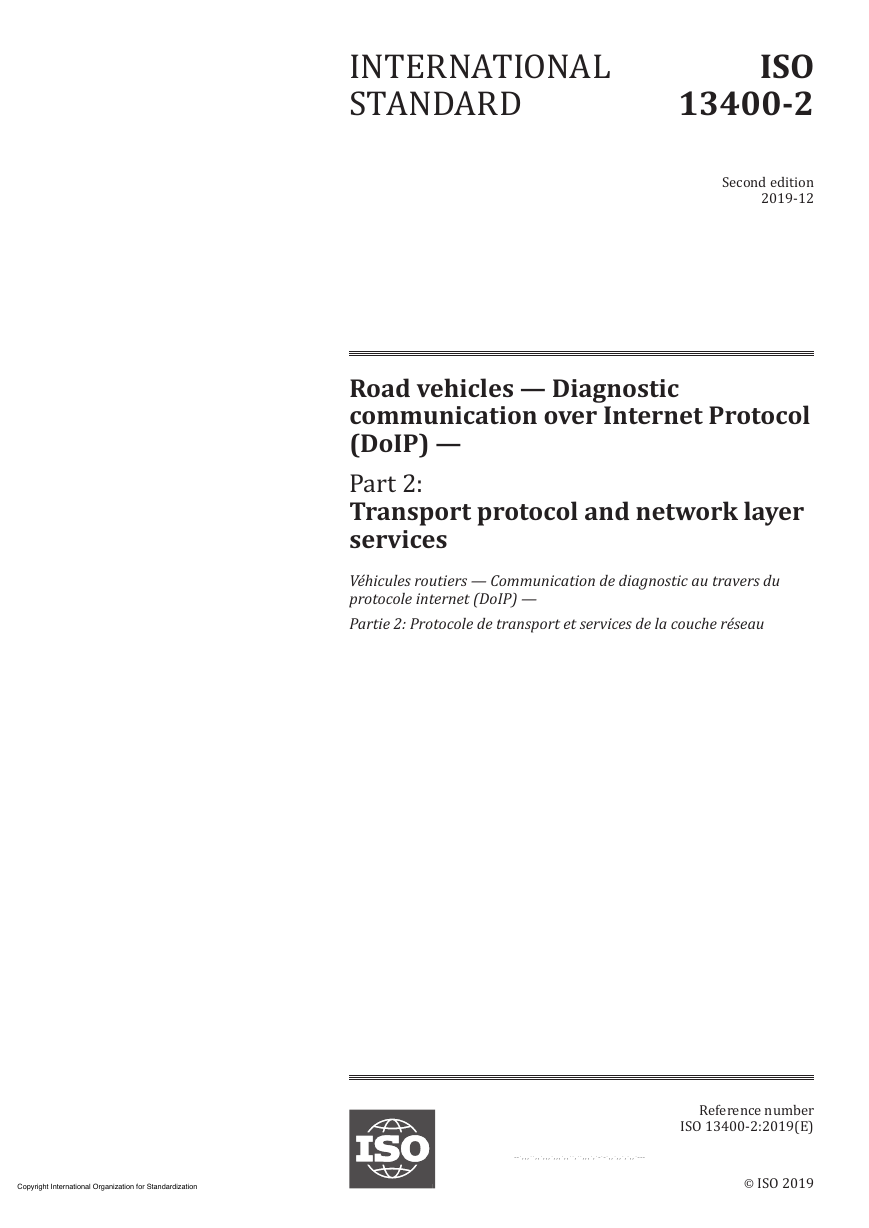

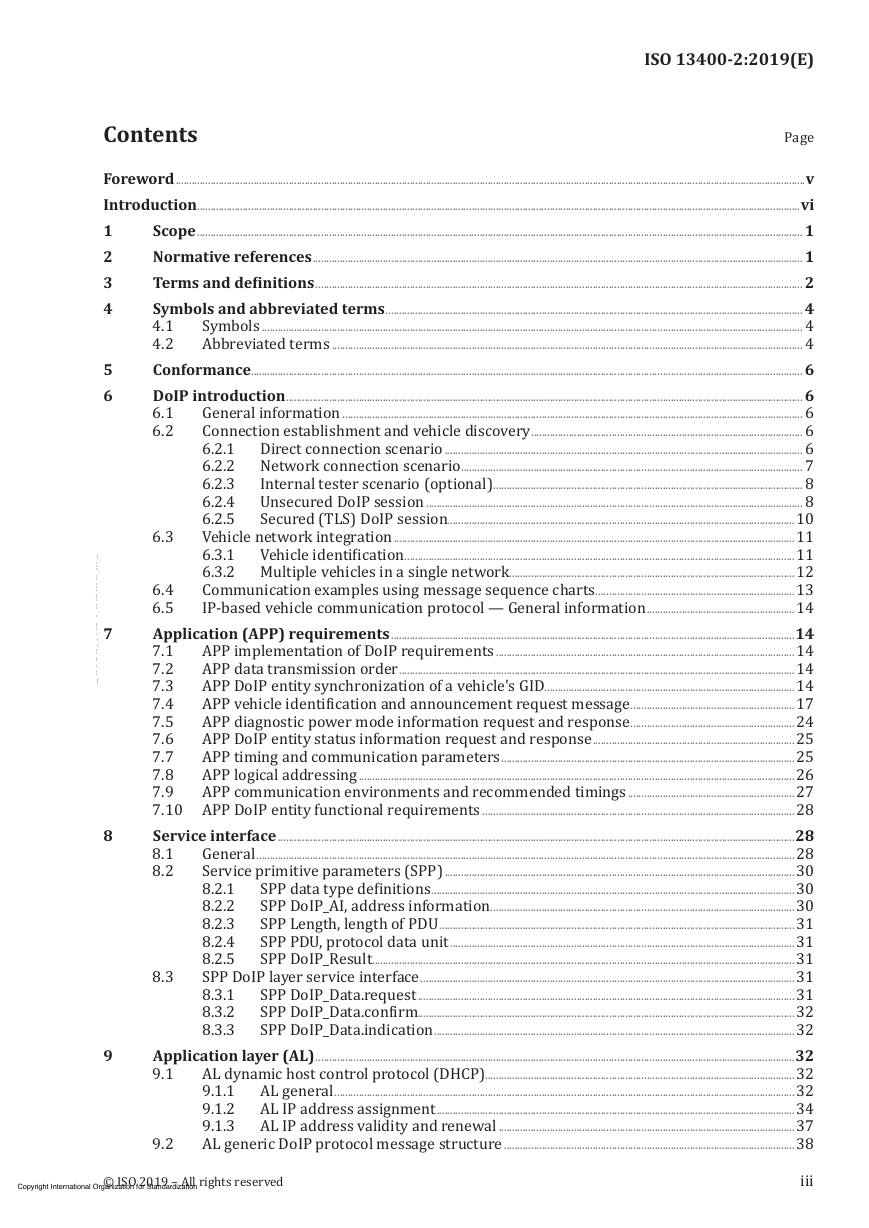
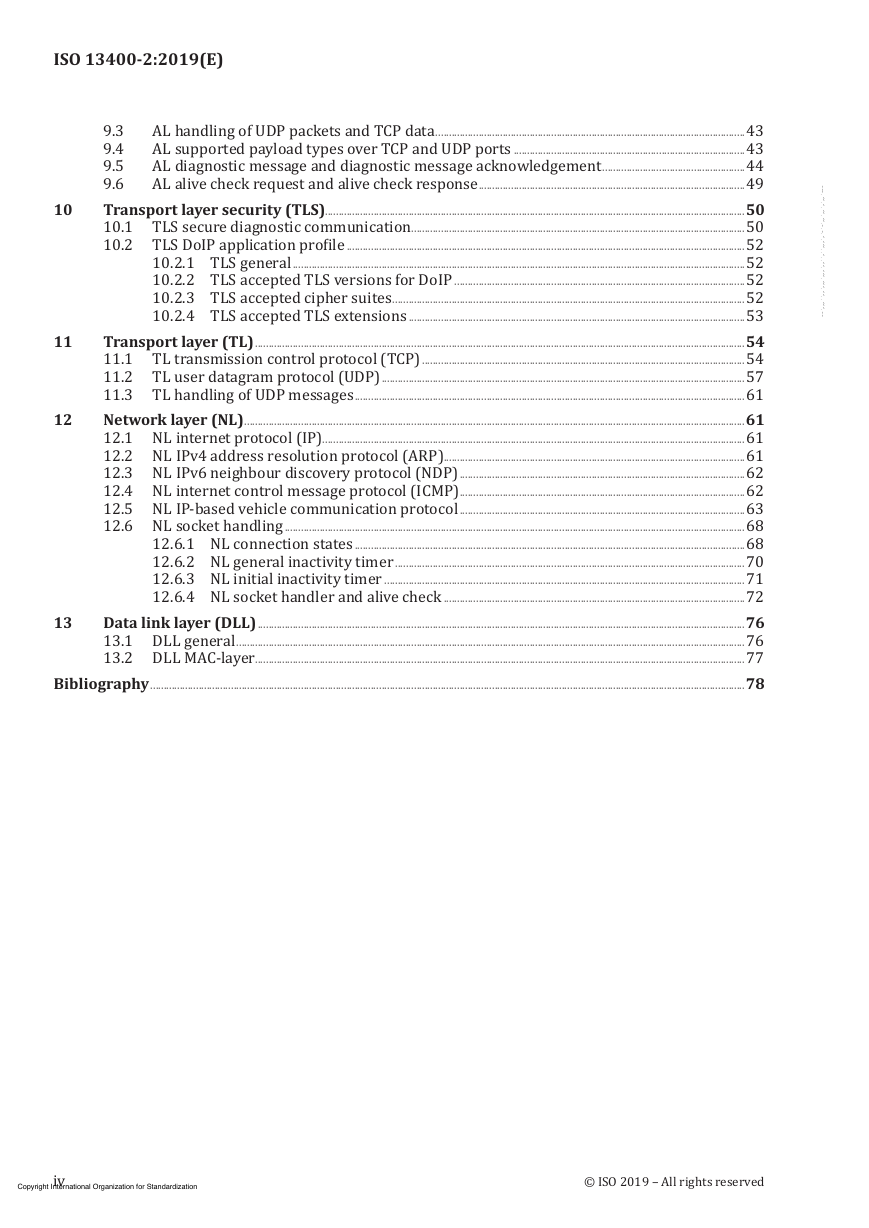
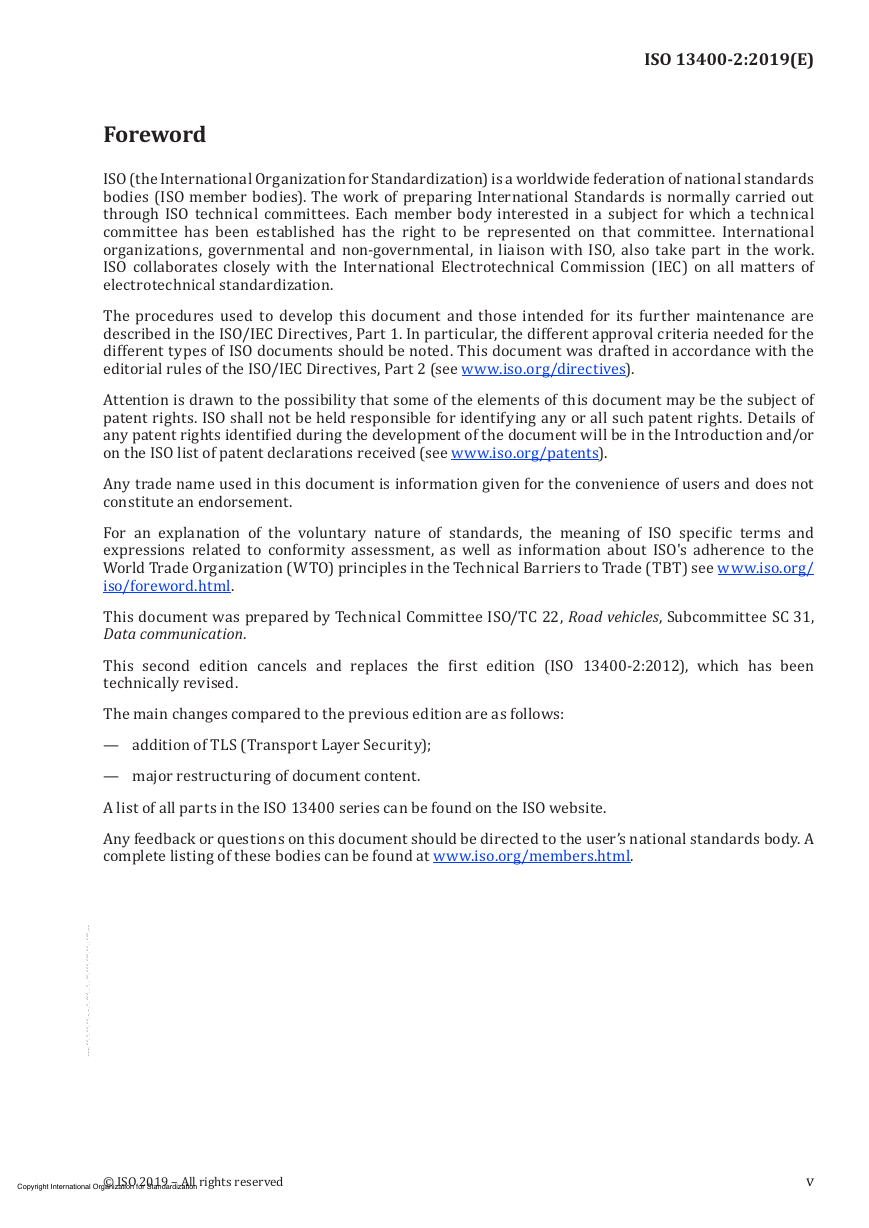
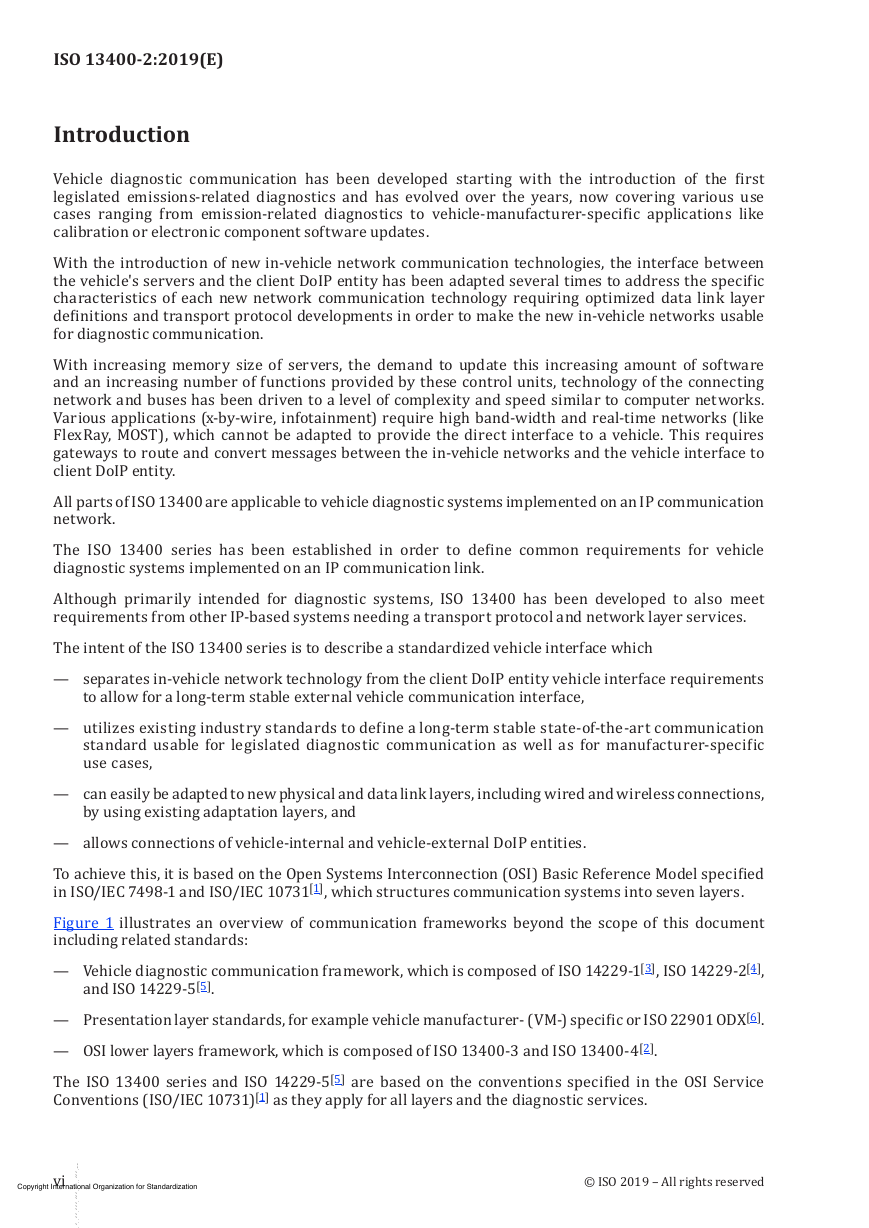

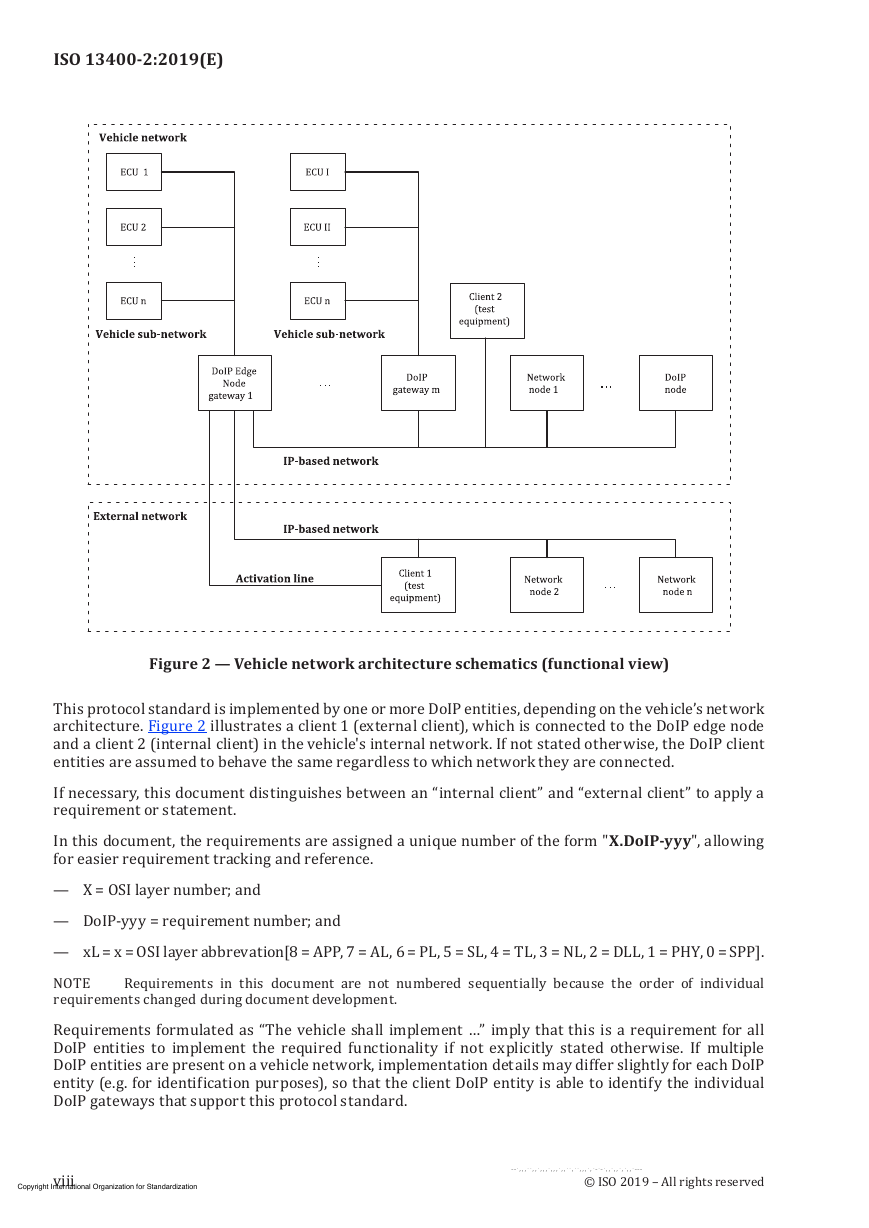








 2023年江西萍乡中考道德与法治真题及答案.doc
2023年江西萍乡中考道德与法治真题及答案.doc 2012年重庆南川中考生物真题及答案.doc
2012年重庆南川中考生物真题及答案.doc 2013年江西师范大学地理学综合及文艺理论基础考研真题.doc
2013年江西师范大学地理学综合及文艺理论基础考研真题.doc 2020年四川甘孜小升初语文真题及答案I卷.doc
2020年四川甘孜小升初语文真题及答案I卷.doc 2020年注册岩土工程师专业基础考试真题及答案.doc
2020年注册岩土工程师专业基础考试真题及答案.doc 2023-2024学年福建省厦门市九年级上学期数学月考试题及答案.doc
2023-2024学年福建省厦门市九年级上学期数学月考试题及答案.doc 2021-2022学年辽宁省沈阳市大东区九年级上学期语文期末试题及答案.doc
2021-2022学年辽宁省沈阳市大东区九年级上学期语文期末试题及答案.doc 2022-2023学年北京东城区初三第一学期物理期末试卷及答案.doc
2022-2023学年北京东城区初三第一学期物理期末试卷及答案.doc 2018上半年江西教师资格初中地理学科知识与教学能力真题及答案.doc
2018上半年江西教师资格初中地理学科知识与教学能力真题及答案.doc 2012年河北国家公务员申论考试真题及答案-省级.doc
2012年河北国家公务员申论考试真题及答案-省级.doc 2020-2021学年江苏省扬州市江都区邵樊片九年级上学期数学第一次质量检测试题及答案.doc
2020-2021学年江苏省扬州市江都区邵樊片九年级上学期数学第一次质量检测试题及答案.doc 2022下半年黑龙江教师资格证中学综合素质真题及答案.doc
2022下半年黑龙江教师资格证中学综合素质真题及答案.doc